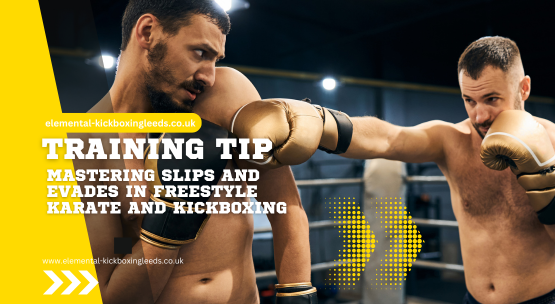
Training Offered
- Join Us Today
- Lead Instructors
- Senior Instructors
- Assistant Instructors
- Medical Doctor
- Club Attire
- Ladies Kickboxing Leeds
- Gradings Leeds 2025
- Gradings Black Belt Leeds
- Contact Sparring
- Fight Club Leeds
- Team Elemental Kickboxing Leeds
- Champions Wall
- Private Coaching Leeds
- Remote Personal Training Leeds
- Online Training Leeds
- Gym Access
- Gym Space Hire Leeds
- Faqs
Latest Posts
16
Nov
Mastering Slips and Evades in Freestyle Karate and Kickboxing
By: Elemental Kickboxing Leeds Kickboxing , freestylekarate, elementalkickboxingleeds

Mastering Slips and Evades in Freestyle Karate and Kickboxing
In freestyle karate and kickboxing, effective defence can make the difference between victory and defeat. Among the most crucial defensive techniques are slips and evades. These fundamental moves not only enhance a fighter’s defence but also play a vital role in their overall strategy. Let’s explore why these techniques are so important and how they can elevate a fighter’s performance.
Defence and Avoiding Damage
In both freestyle karate and kickboxing, slips involve moving the head off the centreline to avoid an incoming strike, while evades rely on footwork or body movement to stay out of an opponent’s range. Both techniques aim to prevent getting hit, reducing the risk of injury and knockdowns. By mastering slips and evades, fighters can stay in the match longer, take less damage, and maintain their ability to compete.
Maintaining Energy and Stamina
Every strike a fighter avoids prevents injury, but it also conserves energy. Absorbing kicks and punches can sap stamina, making a fighter less effective as the rounds progress. By slipping or evading, a fighter preserves energy, allowing them to stay sharp and maintain their best performance over the course of the match.
Creating Counter-Attack Opportunities
Slips and evades don’t just protect; they create openings. When an opponent misses, they can be left off-balance or exposed, giving fighters the chance to counter-attack. In freestyle karate and kickboxing, this could mean slipping a punch to land a kick or evade a high kick to counter with a strike to the body. Defence seamlessly turns into offense, giving fighters control over the momentum.
Ring General ship and Control
Good slipping and evading skills allow a fighter to control the flow of the fight. By consistently making the opponent miss, a fighter can frustrate their rival, forcing them into mistakes or making them hesitate. This level of control is crucial in managing the pace of a match and mentally dominating the opponent.
Minimising Cumulative Damage
Even strikes that don’t knock you down can add up over time, leading to long-term physical toll. By mastering slips and evades, fighters minimise the number of blows they absorb, reducing the risk of cumulative damage. This keeps them healthier not just for the current fight, but throughout their fighting career.
Boosting Confidence and Psychology
Successfully slipping or evading strikes can boost a fighter’s confidence. The psychological boost can shift the momentum of the fight, as a confident fighter is more likely to take control and pressure their opponent. Frustrating an opponent can mentally wear them down, leading to more mistakes and making them more vulnerable to attacks.
Setting Up Tactical Opportunities
Experienced fighters use slips and evades to set tactical traps. For example, slipping a jab might position a fighter perfectly for a counter roundhouse kick or body punch. These tactical setups can lead to fight-changing combinations that catch opponents off guard.
Slips and evades are essential elements of a well-rounded defensive strategy in freestyle karate and kickboxing. They require sharp reflexes, precise timing, and agile footwork. By mastering these techniques, fighters not only improve their defence but also create opportunities to counter, manage the pace, and ultimately become more formidable in the ring.




